沪教版牛津上海小学六年级上册英语阅读试题及答案
沪教版牛津上海小学六年级上册英语阅读理解练习题含答案
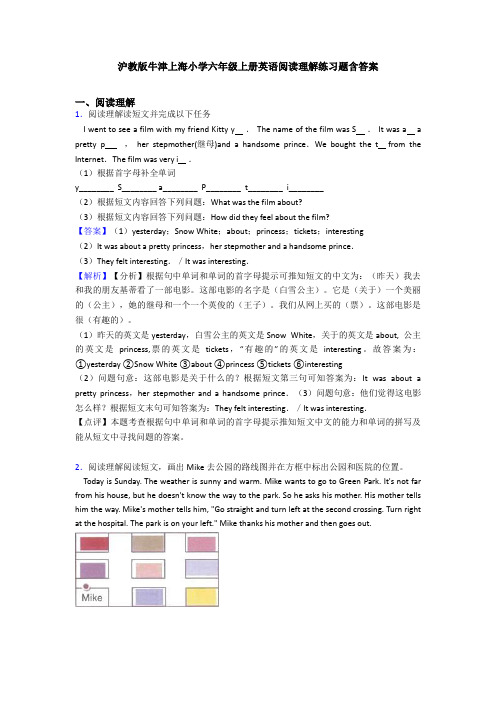
沪教版牛津上海小学六年级上册英语阅读理解练习题含答案一、阅读理解1.阅读理解读短文并完成以下任务I went to see a film with my friend Kitty y . The name of the film was S . It was a a pretty p ,her stepmother(继母)and a handsome prince.We bought the t from the Internet.The film was very i .(1)根据首字母补全单词y________ S________ a________ P________ t________ i________(2)根据短文内容回答下列问题:What was the film about?(3)根据短文内容回答下列问题:How did they feel about the film?【答案】(1)yesterday;Snow White;about;princess;tickets;interesting(2)It was about a pretty princess,her stepmother and a handsome prince.(3)They felt interesting./It was interesting.【解析】【分析】根据句中单词和单词的首字母提示可推知短文的中文为:(昨天)我去和我的朋友基蒂看了一部电影。
这部电影的名字是(白雪公主)。
它是(关于)一个美丽的(公主),她的继母和一个一个英俊的(王子)。
我们从网上买的(票)。
这部电影是很(有趣的)。
(1)昨天的英文是yesterday,白雪公主的英文是Snow White,关于的英文是about, 公主的英文是princess,票的英文是tickets,“有趣的”的英文是interesting。
故答案为:①yesterday ②Snow White ③about ④princess ⑤tickets ⑥interesting(2)问题句意:这部电影是关于什么的?根据短文第三句可知答案为:It was about a pretty princess,her stepmother and a handsome prince.(3)问题句意:他们觉得这电影怎么样?根据短文末句可知答案为:They felt interesting./It was interesting.【点评】本题考查根据句中单词和单词的首字母提示推知短文中文的能力和单词的拼写及能从短文中寻找问题的答案。
沪教版牛津上海小学六年级上册英语阅读理解及答案
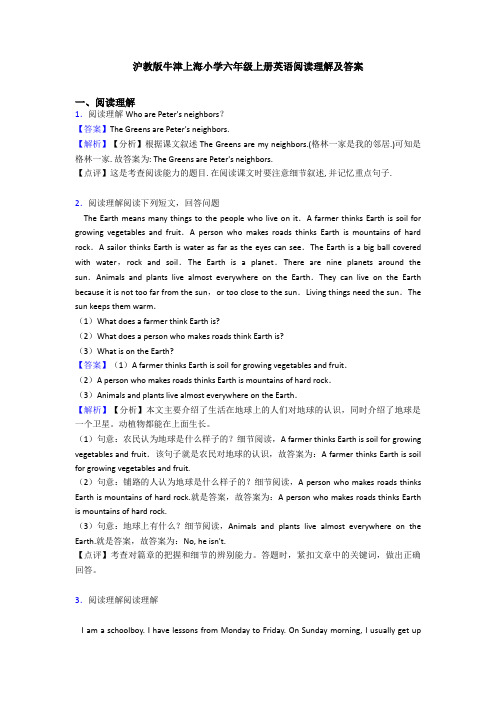
沪教版牛津上海小学六年级上册英语阅读理解及答案一、阅读理解1.阅读理解Who are Peter's neighbors?【答案】The Greens are Peter's neighbors.【解析】【分析】根据课文叙述The Greens are my neighbors.(格林一家是我的邻居.)可知是格林一家. 故答案为: The Greens are Peter's neighbors.【点评】这是考查阅读能力的题目. 在阅读课文时要注意细节叙述, 并记忆重点句子.2.阅读理解阅读下列短文,回答问题The Earth means many things to the people who live on it.A farmer thinks Earth is soil for growing vegetables and fruit.A person who makes roads thinks Earth is mountains of hard rock.A sailor thinks Earth is water as far as the eyes can see.The Earth is a big ball covered with water,rock and soil.The Earth is a planet.There are nine planets around the sun.Animals and plants live almost everywhere on the Earth.They can live on the Earth because it is not too far from the sun,or too close to the sun.Living things need the sun.The sun keeps them warm.(1)What does a farmer think Earth is?(2)What does a person who makes roads think Earth is?(3)What is on the Earth?【答案】(1)A farmer thinks Earth is soil for growing vegetables and fruit.(2)A person who makes roads thinks Earth is mountains of hard rock.(3)Animals and plants live almost everywhere on the Earth.【解析】【分析】本文主要介绍了生活在地球上的人们对地球的认识,同时介绍了地球是一个卫星。
沪教版牛津上海小学六年级上册英语阅读试题及答案及答案解析
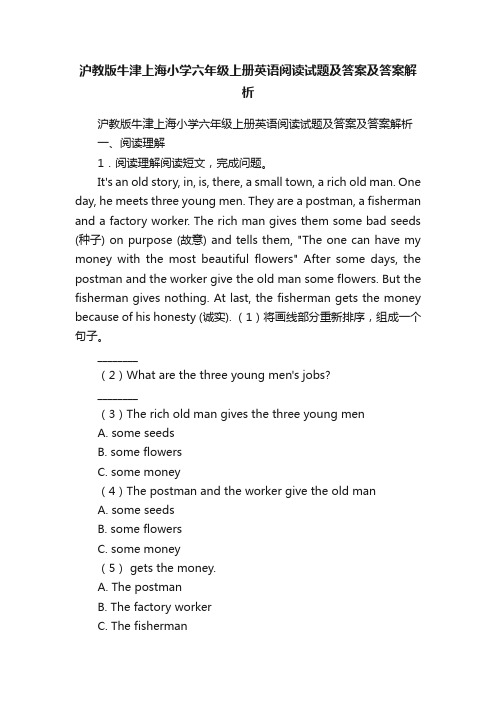
沪教版牛津上海小学六年级上册英语阅读试题及答案及答案解析沪教版牛津上海小学六年级上册英语阅读试题及答案及答案解析一、阅读理解1.阅读理解阅读短文,完成问题。
It's an old story, in, is, there, a small town, a rich old man. One day, he meets three young men. They are a postman, a fisherman and a factory worker. The rich man gives them some bad seeds (种子) on purpose (故意) and tells them, "The one can have my money with the most beautiful flowers" After some days, the postman and the worker give the old man some flowers. But the fisherman gives nothing. At last, the fisherman gets the money because of his honesty (诚实). (1)将画线部分重新排序,组成一个句子。
________(2)What are the three young men's jobs?________(3)The rich old man gives the three young menA. some seedsB. some flowersC. some money(4)The postman and the worker give the old manA. some seedsB. some flowersC. some money(5) gets the money.A. The postmanB. The factory workerC. The fisherman【答案】(1)There is a rich old man in a small town.(2)They are a postman, a fisherman and a factory worker.(3)A(4)B(5)C【解析】【分析】这篇短文讲述了一位富人给了三个人坏花籽, 来测试他们的诚实, 让他们种出最美丽的花. 最后没有种出花的那位诚实的渔民得到了奖赏.(1)这是连词成句, in 在, is系动词, there这儿, a small town一座小镇, a rich old man一位年老的富人. 根据所给单词这是There be 句型, 组成句子: There is a rich old man in a small town. (在一个小镇有一位年老的富人.) 故答案为: There is a rich old man in a small town. (2)这是细节理解, 根据短文句子They are a postman, a fisherman and a factory worker. (他们是邮递员,渔民和工厂工人. )可知他们职业是a postman, a fisherman 和a factory worker. 故答案为: They are a postman, a fisherman and a factory worker.(3)这是细节理解, 根据短文句子The rich man gives them some bad seeds(富人给了他们一些坏种子.)可知给了他们seeds. A选项是: 一些种子, B选项是: 一些花, C选项是: 一些钱. 故答案为: A.(4)这是细节理解, 根据短文句子the postman and the worker give the old man some flowers.(邮递员和工人给了这位老人一些花.) 可知是给了some flowers. 根据选项, 答案为: B.(5)这是细节理解, 根据短文句子At last, the fisherman gets the money because of his honesty.(最后, 渔民因为他的诚实得到了钱.) 可知是渔民得到了钱. A 选项是: 邮递员, B选项是: 工厂工人, C选项是: 渔民., 答案为: C.【点评】这是考查阅读能力的题目. 对于任务型阅读, 首先要掌握问题要求做什么, 然后根据问题找到答案.2.阅读理解阅读短文,选择正确答案。
沪教版牛津上海小学六年级上册英语阅读试题及答案及答案
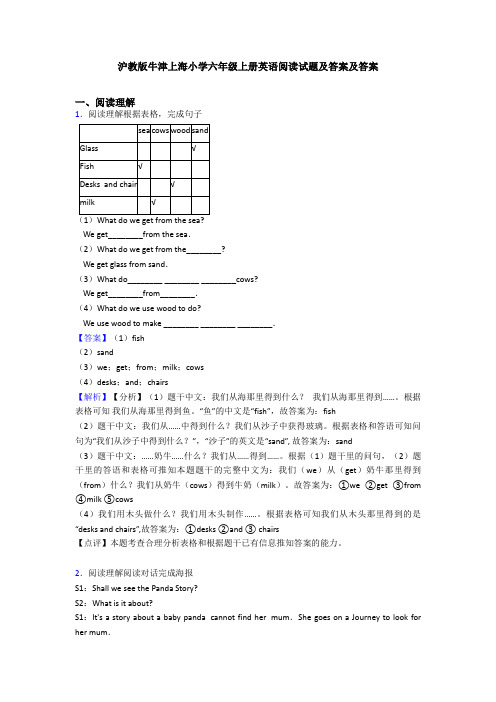
沪教版牛津上海小学六年级上册英语阅读试题及答案及答案一、阅读理解1.阅读理解根据表格,完成句子We get________from the sea.(2)What do we get from the________?We get glass from sand.(3)What do________ ________ ________cows?We get________from________.(4)What do we use wood to do?We use wood to make ________ ________ ________.【答案】(1)fish(2)sand(3)we;get;from;milk;cows(4)desks;and;chairs【解析】【分析】(1)题干中文:我们从海那里得到什么?我们从海那里得到……。
根据表格可知我们从海那里得到鱼。
“鱼”的中文是“fish”,故答案为:fish(2)题干中文:我们从……中得到什么?我们从沙子中获得玻璃。
根据表格和答语可知问句为“我们从沙子中得到什么?”,“沙子”的英文是“sand”, 故答案为:sand(3)题干中文:……奶牛……什么?我们从……得到……。
根据(1)题干里的问句,(2)题干里的答语和表格可推知本题题干的完整中文为:我们(we)从(get)奶牛那里得到(from)什么?我们从奶牛(cows)得到牛奶(milk)。
故答案为:①we ②get ③from ④milk ⑤cows(4)我们用木头做什么?我们用木头制作……。
根据表格可知我们从木头那里得到的是“desks and chairs”,故答案为:①desks ②and ③ chairs【点评】本题考查合理分析表格和根据题干已有信息推知答案的能力。
2.阅读理解阅读对话完成海报S1:Shall we see the Panda Story?S2:What is it about?S1:It's a story about a baby panda cannot find her mum.She goes on a Journey to look for her mum.S2:How is the story?S1:It's interesting!S2:Ok.Shall we see it at Sunny Cinema?S1:Great.It's not far from here.Let's go and see the Panda Story this afternoon.a baby panda cannot find her mum.She goes on a journey to look for her mum.;interesting【解析】【分析】(1)根据语句“Shall we see it at Sunny Cinema?”中的“Sunny Cinema”可知答案为:Sunny(2)根据语句“Shall we see the Panda Story?”可知电影的名字(Movie’s name)是:Panda Story(3)根据语句“It's a story about a baby panda cannot find her mum.She goes on a Journey to look for her mum.”可知答案为:a baby panda cannot find her mum.She goes on a journey to look for her mum.(4)根据语句“How is the story? It's interesting!”可知“它是一个(有趣的)故事。
沪教版牛津上海小学六年级上册英语阅读理解及答案
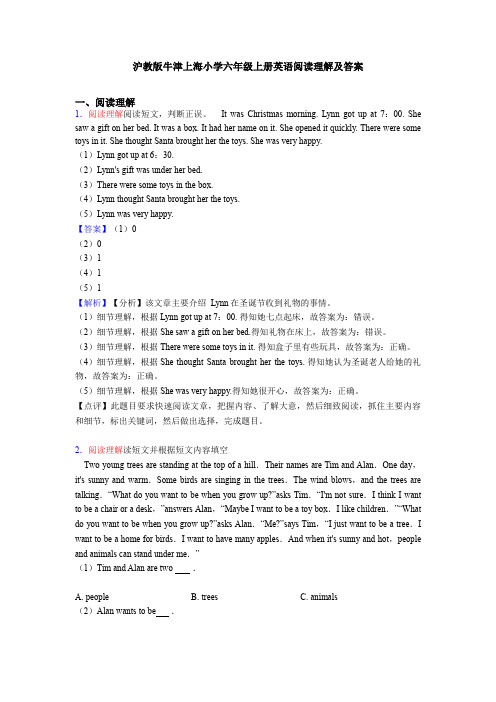
沪教版牛津上海小学六年级上册英语阅读理解及答案一、阅读理解1.阅读理解阅读短文,判断正误。
It was Christmas morning. Lynn got up at 7:00. She saw a gift on her bed. It was a box. It had her name on it. She opened it quickly. There were some toys in it. She thought Santa brought her the toys. She was very happy.(1)Lynn got up at 6:30.(2)Lynn's gift was under her bed.(3)There were some toys in the box.(4)Lynn thought Santa brought her the toys.(5)Lynn was very happy.【答案】(1)0(2)0(3)1(4)1(5)1【解析】【分析】该文章主要介绍 Lynn在圣诞节收到礼物的事情。
(1)细节理解,根据Lynn got up at 7:00. 得知她七点起床,故答案为:错误。
(2)细节理解,根据She saw a gift on her bed.得知礼物在床上,故答案为:错误。
(3)细节理解,根据There were some toys in it. 得知盒子里有些玩具,故答案为:正确。
(4)细节理解,根据She thought Santa brought her the toys. 得知她认为圣诞老人给她的礼物,故答案为:正确。
(5)细节理解,根据She was very happy.得知她很开心,故答案为:正确。
【点评】此题目要求快速阅读文章,把握内容、了解大意,然后细致阅读,抓住主要内容和细节,标出关键词,然后做出选择,完成题目。
沪教版牛津上海小学六年级上册英语阅读试题含答案解析

沪教版牛津上海小学六年级上册英语阅读试题含答案解析一、阅读理解1.阅读理解根据短文内容,判断正误Jack and Sally are brother and sister. They are twins. They like swimming and riding bikes. They like flying kites, too. They often (经常) run with the kites near the river . The kites are very high. They look very happy (高兴)But not all of their favourite games are the same. Jack likes playing football and Sally likes playing basketball. Jack likes jumping high, he thinks it's easy, but Sally thinks it's very hard. Sally likes making something, but Jack can't . Sally can sing well and Jack can throw the yo-yo very well.(1)Jack and Sally are brothers .(2)They like flying kites .(3)They often run with the kites near the river .(4)Jack likes playing basketball .(5)Sally thinks high jump is easy .【答案】(1)0(2)1(3)1(4)0(5)0【解析】【分析】该文章主要介绍Jack和Sally这对双胞胎喜欢的事情。
沪教版牛津上海小学六年级上册英语阅读试题含答案
沪教版牛津上海小学六年级上册英语阅读试题含答案一、阅读理解1.阅读理解It's Jimmy's birthday and he is 9 years old. He gets a lot of presents from his family and one of them is a big drum (鼓). His grandfather buys it for him.Jimmy likes it very much. He plays with it every day and he often makes a terrible noise (令人讨厌的声音). His father works in the day and Jimmy is in bed when he gets home in the evening. So his father doesn't hear the noise.But Mrs Black doesn't like the noise, so one morning she takes a knife and goes to Jimmy's room when he hits his drum. She says to him, “Hello! Jimmy. Do you know there is something very nice in your drum? Here is a knife. Please open the drum and let's find it.”(1)What does Jimmy get on his birthday?A. He gets only one present from his family.B. He gets a lot of presents.C. He gets a knife and a drum.D. He gets a drum from Mrs Black.(2)Who gives Jimmy a drum?A. His mother.B. His father.C. His father's friend.D. His grandfather.(3)When his father gets home in the evening, what does Jimmy do?A. He hits his drum with his grandfather.B. He watches TV with Mrs Black.C. He sleeps in bed.D. He does his homework with his grandfather.(4)What's the Chinese for “hits” in this passage (文章)?A. 敲击B. 拿着C. 知道D. 看见(5)Why does Mrs. Black give Jimmy a knife?A. Because she likes Jimmy's drum.B. Because she knows there is something in the drum.C. Because she doesn't like the noise.D. Because she wants to know what is in the drum.【答案】(1)B(2)D(3)C(4)A(5)C【解析】【分析】大意:讲述吉姆生日收到礼物的的一些事情。
沪教版牛津上海小学六年级上册英语阅读试题及答案及答案
沪教版牛津上海小学六年级上册英语阅读试题及答案及答案一、阅读理解1.阅读理解阅读短文,根据短文填空 It is Saturday. The Browns are at home. Mrs. Brown is in the kitchen. She is making lunch. Mr. Brown isn't in the living room. He is outside. He is washing his car. The car is new and very beautiful. Jim is playing football with some boys. Where is his sister, Sue? She's watching TV in her bedroom with her friend, Ann.(1)There are ________people in Mr. Brown's family.(2)Mrs. Brown is ________.(3)Mr. Brown is ________his car.(4)________is playing football.(5)Sue and Ann are ________in Sue's bedroom.【答案】(1)four(2)making lunch(3)washing(4)Jim(5)watching TV【解析】【分析】通读短文了解到,星期六布朗一家在家正在做什么,妈妈正在做饭,爸爸正在洗车,吉姆正在和孩子们踢球,妹妹正在和她的朋友看电视。
(1)通读短文知道,布朗一家有四口人,爸爸,妈妈,哥哥和妹妹。
故答案为four.(2)根据所给的短文,Mrs. Brown is in the kitchen. She is making lunch. 布朗太太在厨房里。
她正在做午饭。
沪教版牛津上海六年级上册英语阅读题含答案
沪教版牛津上海六年级上册英语阅读题含答案一、阅读理解1.阅读理解根据图片提示完成短文If Alice is not at home, You know where she will be.She always goes to museums,For the wonderful things she can see.She goes to see ________ on the ground floor.She goes to see ________on the first floor.She goes to see ________on the second floor.She goes to see ________ on the third floor.She goes to see ________on the fourth floor.She learns a lot in museums.There is always great joy in her heart.【答案】insects;art;robots;films;history【解析】【分析】(1)句意:她去一楼看……。
根据图片可知一楼是有关“昆虫(insects)”的,故答案为:insects(2)句意:她去二楼看……。
根据图片可知二楼是有关“美术(art)”的,故答案为:art (3)句意:她去三楼看……。
根据图片可知三楼是有关“机器人(robots)”的,故答案为:robots(4)句意:她去四楼看……。
根据图片可知四楼是有关“电影(films)”的,故答案为:films(5)句意:她去五楼看……。
根据图片可知五楼是有关“历史(history)”的,故答案为:history【点评】本题考查正确分析图片,正确理解句意和牢固掌握单词的拼写。
2.阅读理解读短文并按要求完成相应任务Today was the first day of the summer holiday.My friends and I went out together.We wentswimming in the swimming pool.We swam for an hour.I did not swim well,but I enjoyed it very much.We had lunch in a fast—food restaurant.I had a sandwich and some orange juice.Alice had a hamburger.Jack had a lot of French fries and some cola.We went shopping in a supermarket.I bought a pink dress.Alice bought a pretty hat.Jack did not buy anything.We went home at 3 o'clock in the afternoon.We 、were tired,but we were happy.(1)写出短文中6个动词的一般过去式。
沪教版牛津上海小学六年级上册英语阅读试题及答案及答案
沪教版牛津上海小学六年级上册英语阅读试题及答案及答案一、阅读理解1.阅读理解阅读理解(C)Look at all the kinds of drinks on the table.There are milk tea, water, fruit juice,milk and fizzy drinks(碳酸饮料).What should we drink? Coke,a kind of fizzy drink,tastes great,but it is really bad for your teeth and bones.It has a lot of sugar.Some drinks are good for us.Some are not.The doctors tell us to drink water and milk.Our body has lots of jobs and it needs water to do many of them.Milk is good for your eyes and bones.(1)We should not drinkA. milkB. fizzy drinkC. fruit juice(2)Why shouldn't we drink Coke?A. Coke tastes great.B. Coke is bad for your teeth and bones.C. Coke is very expensive..(3)The doctors tell us to drinkA. milk and waterB. milk teaC. Coke and juice(4)Milk is good for ourA. eyesB. bonesC. both A and B(5)According to the passage,which of the following is NOT TRUE(不正确)?A. Milk tea,water, fruit juice and milk are not fizzy drinks.B. All drinks are good for us.C. Coke is really bad for your body.【答案】(1)B(2)B(3)A(4)C(5)B【解析】【分析】大意:介绍桌子上各种各样的饮料。
- 1、下载文档前请自行甄别文档内容的完整性,平台不提供额外的编辑、内容补充、找答案等附加服务。
- 2、"仅部分预览"的文档,不可在线预览部分如存在完整性等问题,可反馈申请退款(可完整预览的文档不适用该条件!)。
- 3、如文档侵犯您的权益,请联系客服反馈,我们会尽快为您处理(人工客服工作时间:9:00-18:30)。
沪教版牛津上海小学六年级上册英语阅读试题及答案一、阅读理解1.阅读理解阅读理解(A)Sydney is a big city but not the capital in Australia.It's in the east of Australia.There are many museums and parks in Sydney.Sydney Opera House is very famous all over the world.People can watch excellent shows there.There are also many wonderful beaches there.People can swim in the sea.Tourists can see koala bears,kangaroos and other interesting animals at the zoo in Sydney.Koala bears and Kangaroos are the animals in Australia.The seafood there tastes great, too.It takes 7 hours to get there from Hongkong Airport.根据短文内容,判断一下内容是否正确。
(1)Sydney is the capital city in Australia.(2)We can go to Sydney Opera House to watch shows.(3)There are only kangaroos and koala bears in Australia.(4)We can fly to Sydney from Hongkong.(5)Tourists can eat seafood in Sydney.【答案】(1)0(2)1(3)0(4)1(5)0【解析】【分析】大意:介绍澳大利亚悉尼的城市文化。
(1)根据Sydney is a big city but not the capital in Australia可知,悉尼不是澳大利亚的首都。
故选错误。
(2)根据Sydney Opera House is very famous all over the world.People can watch excellent shows there可知,人们确实可以在悉尼歌剧院观看表演。
故选正确。
(3)根据Koala bears and Kangaroos are the animals in Australia可知,考拉跟袋鼠是澳大利亚的动物,但不是唯一的。
故选错误。
(4)根据It takes 7 hours to get there from Hongkong Airport可知,从香港机场飞到悉尼需要7小时。
故选正确。
(5)根据People can swim in the sea可知,人们可以在悉尼海边游泳。
故选错误。
【点评】考查阅读理解。
首先通读全文,理解大意。
其次阅读问题,根据题干信息找出相关句子进行判断。
2.阅读理解阅读短文,为Kitty和Joe选择相应的食物Kitty:What did you have for breakfast,Joe?Joe:I had some noodles for breakfast.What about you,Kitty?Kitty:I had a sandwich and a glass of milk for breakfast.Joe:What did you have for lunch yesterday,Kitty?Kitty:I had a salad for lunch.What about you,Joe?Joe:I had a hamburger and some chips for lunch.What did you have for dinner yesterday,Kitty?Kitty:I had some pizza and fruit for dinner.【解析】【分析】(1)D含义是一份三明治。
E含义是牛奶。
此题关键词是Kitty的breakfast早餐。
根据对话内容第三行可知,故填写DE。
(2)C含义是一份沙拉。
此题关键词是Kitty的lunch午餐。
根据对话第五行内容可知。
故填写C。
(3)I含义披萨,G含义是水果。
此题关键词是Kitty的晚餐,根据对话最后一句可知,故填写IG。
(4)F含义是面条。
此题关键词是Joe的早餐,故填写F。
(5)H含义是一个汉堡包,J含义是薯片。
此题关键词是Joe的午餐,根据对话第六行内容可知,故填写HJ。
【点评】考查名词。
同学平时要多记忆有关食物类的名词。
3.阅读理解根据短文内容判断下列句子正误Today is Saturday. Mike is going to the nature park with his classmates. They are going there by bus and the bus station is close to Mike's home. The nature park is a little far, but the No.6 bus will take them there. He also has plans for tomorrow. He is going to the bookstore and buy some comic books on Sunday morning. In the evening, he is going to see a film. He will have a good time on the weekend.(1)It is Friday today.(2)They are going to the nature park by bus.(3)They will take the No.7 bus.(4)Mike is going to buy some word books on Sunday morning.(5)Mike is going to see a film on Sunday evening.【答案】(1)0(2)1(3)0(4)0(5)1【解析】【分析】这是介绍Mike和朋友们去自然公园情况的短文。
(1)句意:今天是星期五。
根据短文句子Today is Saturday.可知是星期六。
题目叙述错误。
故答案为:错误。
(2)句意:他们乘公交车去自然公园。
根据短文叙述They are going there by bus(他们乘公交去那里。
)可知题目叙述正确。
故答案为:正确。
(3)句意:他们将乘坐7路公交车。
根据短文叙述but the No.6 bus will take them there.可知是6路公交车。
题目叙述错误。
故答案为:错误。
(4)句意:星期日上午,Mike打算买一些单词书、根据短文叙述He is going to the bookstore and buy some comic books on Sunday morning.(他打算在周日上午去书店买一些漫画书。
)可知是买漫画书。
题目叙述错误。
故答案为:错误。
(5)句意:Mike打算在星期日晚上看电影。
根据短文叙述In the evening, he is going to see a film.(在晚上我打算看场电影。
)可知题目叙述正确。
故答案为:正确。
【点评】这是考查阅读理解的题目。
仔细阅读短文,根据短文的相关叙述来判断正误。
4.阅读理解阅读对话,判断下列各句与对话内容是否相符。
Martin: What do you want to be when you grow up, Jiamin?Jiamin: I want to be a fireman (消防员). I think the fireman is cool.Martin: And you, Lily?Lily: I like children. I want to be a teacher. What about you, Martin?Martin: My father is a police officer. He can stop bad people. So I want to be a police officer. Jiamin: Police officers can help people. Your father is great, Martin.Martin: Thanks. Look, Miss Wang is working hard. I think teachers are great, too.(1)Jiamin wants to be a firefighter.(2)Lily wants to be a doctor.(3)Martin's father is a farmer.(4)Police officers can stop bad people.(5)Miss Wang is a teacher.【答案】(1)1(2)0(3)0(4)1(5)1【解析】【分析】大意:马丁,嘉敏和莉莉谈论长大后想做什么职业。
(1)句意:嘉敏想当一名消防员。
根据Jiamin: I want to be a fireman. 可知嘉敏想当消防员。
故答案为正确。
(2)句意:莉莉想当一名医生。
根据 Lily: I like children. I want to be a teacher. 可知莉莉想当一名老师。
故答案为错误。
(3)句意:马丁的父亲是一个农民。
根据 Martin: My father is a police officer. 可知马丁的父亲是一名警察。
故答案为错误。
(4)句意:警察可以制止坏人。
根据 He can stop bad people. So I want to be a police officer. 可知警察可以制止坏人。
故答案为正确。
(5)句意:王小姐是一名教师。
根据Martin: Thanks. Look, Miss Wang is working hard. I think teachers are great, too. 可知王小姐是一名教师。
故答案为正确。
【点评】本题考查了阅读理解,先翻译对话,然后根据对话内容,判断句子正确或错误。
5.阅读理解阅读理解,判断正误。
